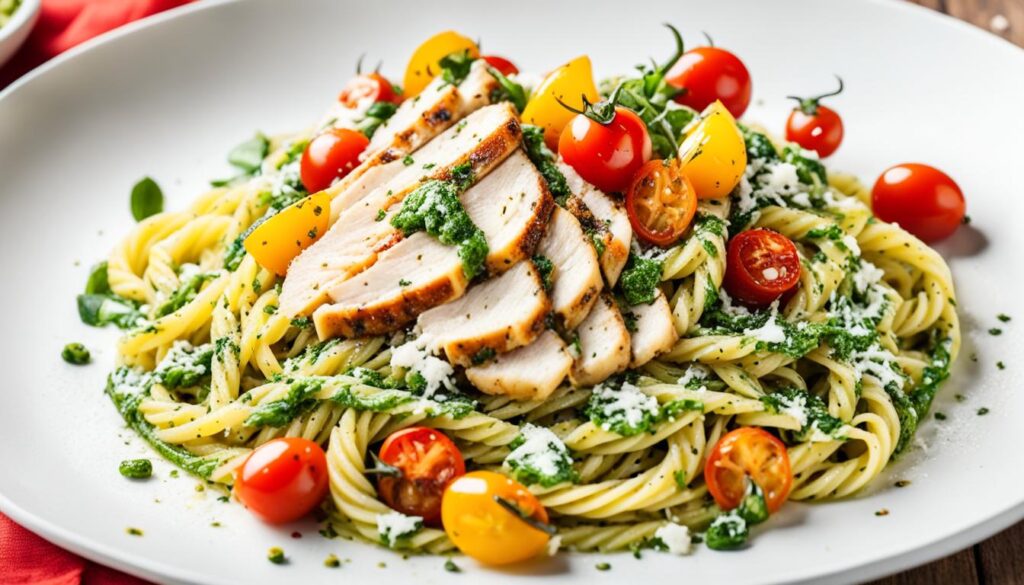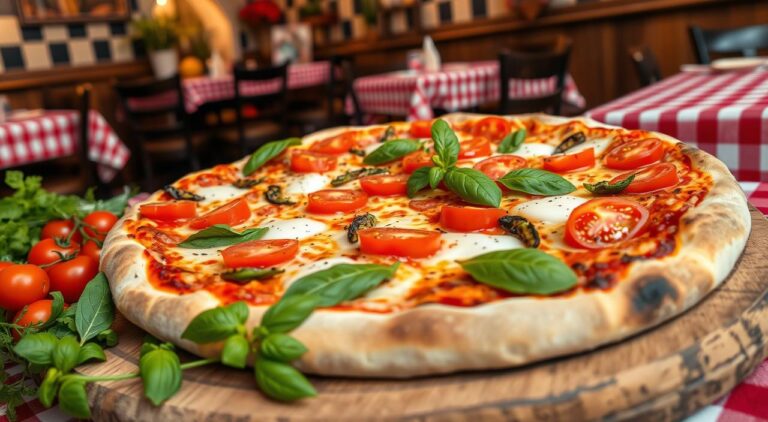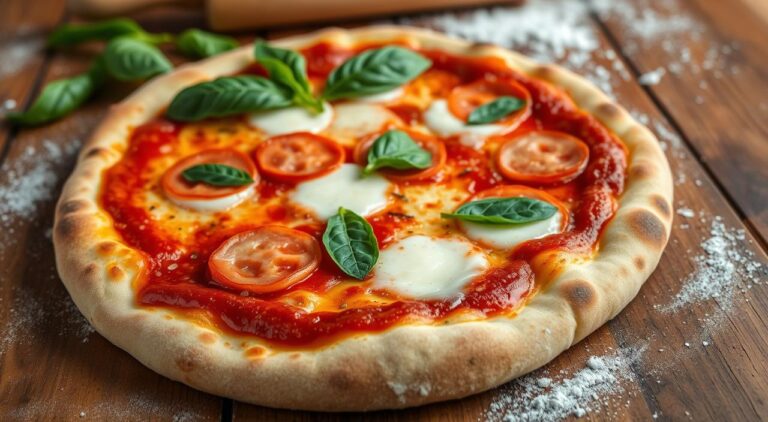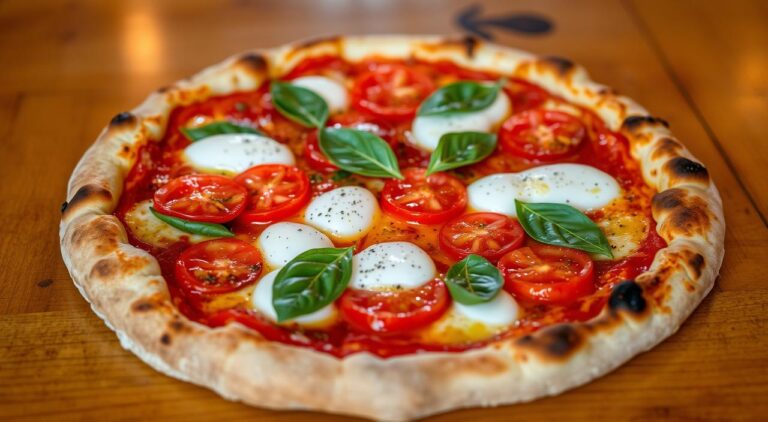Pasta lovers, get ready for a treat! Corkscrew pasta, with its fun spirals, can make any dish special. From the classic fusilli to the cute gemelli and the unique trofie, this pasta shape brings new flavors and textures to your meals.
This article takes you on a journey to explore corkscrew pasta’s history, varieties, and tasty recipes. Whether you’re an expert or new to spiral pasta, twisted pasta, helical pasta, curly pasta, twirled pasta, or coiled pasta, you’ll find lots of ideas to spice up your cooking.
Key Takeaways
- Corkscrew pasta, with its playful spirals and captivating curls, offers a unique texture and flavor experience.
- Explore the history and diverse varieties of corkscrew pasta, from classic fusilli to charming gemelli and intriguing trofie.
- Discover delicious recipes and cooking tips to make the most of this versatile pasta shape.
- Understand the health benefits and pairing options for corkscrew pasta, elevating your meals to new heights.
- Dive into the world of corkscrew pasta and unlock a world of culinary possibilities.
Introducing Corkscrew Pasta
Corkscrew pasta, also known as fusilli, is a delightful type of pasta. It has a spiraled shape that catches the eye. This shape comes from twisting the dough around a rod during the making process.
What is Corkscrew Pasta?
Fusilli, or corkscrew pasta, is a versatile pasta type. It can be made from wheat, semolina, or gluten-free flours. The spiral shape makes it fun and helps it hold onto sauces well.
Varieties of Corkscrew Pasta
Corkscrew pasta comes in many sizes, from thin to thick spirals. This lets cooks pick the right size for their dish. Whether it’s a light salad or a hearty pasta bake, there’s a perfect corkscrew pasta for it.
“The beauty of corkscrew pasta lies in its ability to capture the essence of a dish, adding both visual appeal and textural delight to every bite.”
The History of Corkscrew Pasta
The corkscrew pasta has a long and interesting history. It comes from Italy’s rich food traditions. This unique shape has won over pasta lovers for many years. It goes back to Italy’s lively food culture.
The spiral shape of corkscrew pasta is called “fusilli” in Italian. It was probably inspired by grapevines or snail shells. Cooks in Italy used to twist the dough around a thin rod to make it spiral. This was a hard process that needed a lot of skill and care.
As more people liked corkscrew pasta, making it changed. Hand-rolled fusilli was still a special treat, but machines came in the late 1800s. These machines made it easier to make and share this type of pasta.
Now, corkscrew pasta is a key part of Italian food. It’s found in many dishes from different regions and around the world. From Sicily’s sunny beaches to Tuscany’s hills, its history shows the lasting impact of Italian food traditions.
“The spiral shape of corkscrew pasta is a reflection of the ingenuity and creativity that have long defined Italian cooking.”
| Year | Milestone |
|---|---|
| 16th Century | Corkscrew pasta, or “fusilli,” first appears in Italian culinary records, likely inspired by the natural coils of grapevines or snail shells. |
| Late 19th Century | The introduction of pasta-making machines allows for the mass production and wider distribution of corkscrew pasta shapes. |
| Present Day | Corkscrew pasta remains a beloved staple in Italian cuisine, appearing in a wide range of regional dishes and global culinary creations. |
Corkscrew Pasta Shapes and Sizes
The charm of corkscrew pasta is not just in its spiral shape. It’s also in the variety of shapes and sizes it comes in. From the classic fusilli to the unique gemelli and trofie, each type of corkscrew pasta has its own special texture and uses in cooking.
Fusilli
Fusilli is the most well-known corkscrew pasta shape. It has tight, thin spirals that mix well with many sauces. This makes it a favorite for tasty dishes.
Gemelli
Gemelli pasta stands out with its twisted strands. It adds a unique look to dishes and a fun texture. This makes it great for thick sauces and casseroles.
Trofie
Trofie pasta comes from Liguria, Italy. It’s a short, thick spiral that gives a hearty bite. Its size is perfect for pesto sauces and other rich flavors.
| Pasta Shape | Characteristics | Culinary Pairings |
|---|---|---|
| Fusilli | Tight, thin spirals | Versatile, pairs well with various sauces |
| Gemelli | Twisted strands | Hearty sauces and casseroles |
| Trofie | Shorter, thicker spiral | Pesto sauces and vibrant flavors |
The variety in corkscrew pasta shapes and sizes lets cooks try out different textures and looks. This adds creativity and flair to their dishes.
Cooking with Corkscrew Pasta
Corkscrew pasta adds a fun twist to any meal with its unique spiral shape. But, cooking it right is key for delicious results. Here are some tips for cooking corkscrew pasta to help you get it just right.
Tips for Perfect Corkscrew Pasta
- Use Plenty of Salted Boiling Water: Make sure your pot is big enough and the water is boiling with salt. This lets the pasta cook evenly.
- Stir Frequently: Stir the pasta every minute to stop it from sticking and cook evenly.
- Mind the Cooking Time: Corkscrew pasta can cook too much, so check it a minute before the package says. This helps avoid overcooking.
- Drain and Toss with Sauce: After cooking, drain the corkscrew pasta well and mix it with your favorite sauce for a tasty dish.
Follow these easy tips for cooking corkscrew pasta to improve your cooking and enjoy the fun texture and look of this pasta.
Delicious Corkscrew Pasta Recipes
Corkscrew pasta’s unique shape and texture make it great for many tasty recipes. It’s perfect for both classic Italian dishes and creative twists. This fun pasta can be the main star or add something special to your meals.
A favorite is Pesto Fusilli, where the pasta’s spirals hold onto the vibrant pesto sauce well. Another hit is Corkscrew Mac and Cheese, using gemelli pasta for a fun chewy texture.
For a Mediterranean taste, try Trofie Pasta with Roasted Vegetables and Pesto. The trofie noodles mix well with roasted zucchini, bell peppers, and pesto.
Want something different? Try Corkscrew Pasta Salad with fusilli, veggies, feta, and a tangy dressing. Or go for Chocolate Fusilli Dessert, with chocolate sauce and whipped cream.

Corkscrew pasta offers endless possibilities. Explore these tasty recipes and see how this versatile pasta can make your meals special.
Corkscrew Pasta for Kids
Corkscrew pasta is a big hit with kids for its fun twirly shape and bright colors. It comes in many colors, making meals exciting. The spiral shape also helps kids try new pasta dishes and flavors.
Fun Shapes and Colors
Kids adore corkscrew pasta for its unique shape and colorful choices. Corkscrew pasta comes in classic colors like yellow, red, and green, and vibrant ones like blue, purple, and rainbow. This makes meals fun for young ones.
Using corkscrew pasta for kids can also add more whole grains and fiber to their diet. Many types are made with whole wheat or whole grain, making it a nutritious choice.
“The spiral shape and bright colors of corkscrew pasta make it a hit with kids. It’s a fun way to get them engaged with trying new pasta dishes.”
There are many fun corkscrew pasta shapes for kids, like fusilli and trofie. These shapes can be paired with various sauces and toppings for tasty meals.
| Corkscrew Pasta Shape | Color Options | Recommended Pairings |
|---|---|---|
| Fusilli | Red, Green, Yellow | Tomato-based sauces, Pesto |
| Gemelli | Blue, Purple, Rainbow | Cream-based sauces, Vegetable medleys |
| Trofie | Orange, Pink, White | Light, garlic-based sauces, Seafood dishes |
Adding corkscrew pasta to family meals makes dining fun for kids. Its unique shape and colors make it a great way to introduce new flavors and textures.
Health Benefits of Corkscrew Pasta
Corkscrew pasta is more than just fun to eat; it’s also good for you. Its spiral shape makes meals more exciting. It’s packed with complex carbs that give you energy and keep your blood sugar stable. This makes it a great choice for a healthy meal.
It can also be high in fiber, which is key for your gut health and feeling full. Plus, some types are made with whole grains. These grains add vitamins, minerals, and antioxidants that boost your health.
Here are some of the key health benefits of corkscrew pasta:
- Sustained Energy: The complex carbs in corkscrew pasta are digested slowly. This gives you a steady energy boost throughout the day.
- Digestive Support: The fiber in corkscrew pasta helps with digestion and prevents constipation.
- Nutrient-Rich: Depending on the flour, corkscrew pasta can be full of vitamins and minerals like B vitamins, iron, and magnesium.
- Heart Health: Whole grains in some corkscrew pasta may lower cholesterol and cut down heart disease risk.
Whether you like classic fusilli, delicate gemelli, or unique trofie, adding corkscrew pasta to your meals is tasty and healthy. It’s a great way to support your health and feel good.
| Nutrient | Amount per Serving of Corkscrew Pasta |
|---|---|
| Carbohydrates | 40g |
| Fiber | 3g |
| Protein | 7g |
| Iron | 2mg |
| Magnesium | 30mg |
“Corkscrew pasta is not only a delight to the senses, but it also provides a nutritious foundation for a balanced, delicious meal.”
Pairing Corkscrew Pasta with Sauces
The unique shape of corkscrew pasta makes it great with many sauces. Its tight spirals are perfect for creamy sauces. The curled shape also goes well with bold tomato sauces. Trying different sauces with corkscrew pasta can lead to tasty discoveries.
Cream-Based Sauces
The spiraled shape of corkscrew pasta is ideal for creamy sauces. The pasta’s curves catch and hold the sauce well. This makes every bite a satisfying treat.
Tomato-Based Sauces
Tomato sauces and corkscrew pasta are a great match. The pasta’s shape lets the sauce stick to it, making each bite full of flavor. This classic Italian combo is always a hit.
“The unique shape of corkscrew pasta allows it to capture and hold onto sauces in the most delightful way. It’s a true culinary delight to experience.”
| Pasta Shape | Recommended Sauces |
|---|---|
| Corkscrew Pasta | Cream-based sauces, Tomato-based sauces |
Corkscrew Pasta in World Cuisines
Corkscrew pasta has become a favorite worldwide, beyond its Italian roots. It’s loved for its unique spiral shape. From Genoa’s pesto-coated fusilli to Liguria’s hearty trofie, it’s a staple in many cuisines.
In the Mediterranean, corkscrew pasta is a star. In Greece, gemelli pairs well with feta, olives, and sun-dried tomatoes. Spain enjoys fusilli with saffron and seafood. Morocco uses it in tagines, adding texture to rich stews.
But corkscrew pasta isn’t just a Mediterranean thing. In Asia, it’s great in stir-fries, catching sauces with its shape. In Latin America, fusilli is perfect for pasta salads with fresh veggies and zesty dressings.
“Corkscrew pasta’s versatility allows it to adapt to a wide range of culinary traditions, adding a touch of whimsy and sophistication to every dish it graces.”
Whether it’s creamy mushroom sauce or tangy pesto with seafood, corkscrew pasta wins hearts worldwide. It’s a beloved ingredient across cultures, proving its global appeal.
Storing and Reheating Corkscrew Pasta
Storing and reheating corkscrew pasta right is key to keeping its quality and texture. Whether for a family dinner or quick leftovers, knowing how to store and reheat makes a big difference.
Storing Uncooked Corkscrew Pasta
Keep uncooked corkscrew pasta in a cool, dry spot in an airtight container. This keeps it from drying out or picking up bad smells. Store it in its original packaging or a resealable bag for up to 2 years.
Storing Cooked Corkscrew Pasta
Cooked corkscrew pasta can stay fresh in the fridge for 5 days or in the freezer for months. Cool it down, then put it in an airtight container or a resealable bag. Label the freezer container with the date to remember when you stored it.
Reheating Corkscrew Pasta
Reheat corkscrew pasta on low to medium heat with a bit of water or sauce. This keeps it from drying out. Put the pasta in a pan, add some water or sauce, and heat it slowly, stirring now and then. High heat can make the pasta tough or overcook it.
Follow these easy tips for storing corkscrew pasta and reheating corkscrew pasta. Your favorite pasta dishes will stay tasty and tender, even when you’re enjoying leftovers or making ahead.
Conclusion
Corkscrew pasta has become a favorite in kitchens across the U.S. Its spiral shape and versatility make it a go-to for many. It has a rich history and offers endless ways to be creative with flavors.
It’s perfect for making classic pasta dishes or trying out new recipes. Corkscrew pasta adds fun and excitement to any meal. Its unique texture works well with many sauces and ingredients, making it versatile.
Keep exploring with corkscrew pasta and let it spark your creativity in the kitchen. Enjoy the twists and turns it brings to your dishes. It can take your meals to new levels of taste and fun.










